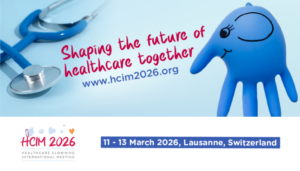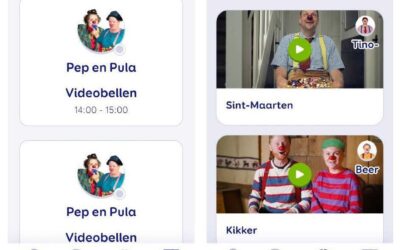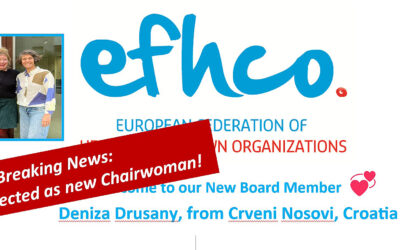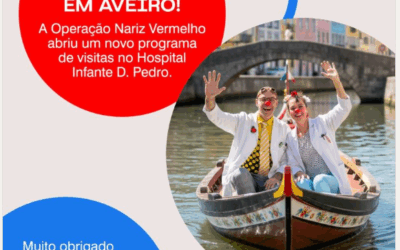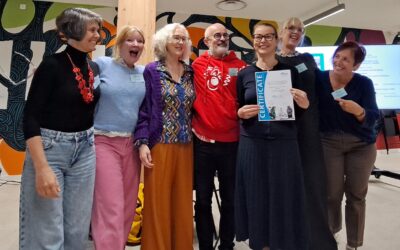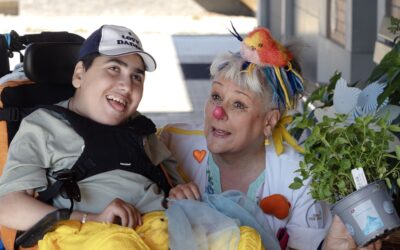«The coat is the final touch of the character»
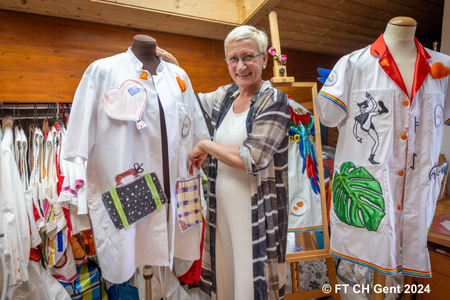
All Théodora Giggle Doctors wear a colorful personalised coat and behind each unique costume are master seamstress Lydia Pfister and her team the creative minds. For over 30 years, Lydia Pfister has been transforming fabric into true works of art for Fondation Théodora. Today, we are looking into the tailoring atelier, discovering some secrets within the creation of those wonderful clown coats. Enjoy the interview with Lydia:
Lydia, how did you come to sew for the Foundation?
At the time, I was looking for a way to volunteer or donate some money to a non-profit-organisation. I saw an article in a newspaper about the Théodora and I thought the project was fantastic and I tried to get in touch with one founder, André Poulie. As I was working as a stylist, André asked me to make a hat for one of the artists. A gavroche hat with a little doll inside for Dr Isidore, was my first piece.
How much steps do you need for a new creation?
The full creation time is about 15 working hours per coat, it starts with the delivery of one to a future Giggle Doctor. During the first training module, we bring these coats to the artists so that they can take their first steps in the hospital. There’s also a brief introduction – also about hygiene – to the coat. In a second module, we do a full presentation of the coat so they can start to imagine their clown character and incorporate a bit of their costume. I give them all the necessary information about the Théodora coat, which is the same for all countries: the orange heart, the orange buttons and the badges.
The next step takes place in our atelier, where we create together the individual coat of the new clown artist, based on his/her ideas and we bring them into life in sketches and creating patterns for the final design. Finally, my seamstresses take over to finish!
Did you ever count how many coats you and your team have made?
A brief calculation came up with 420 different designs and pattern, that makes over 1,250 single clown coats. Each artist receives two coats, and after some years of work, they can also change a design if they like, thus requiring the new creations.
What’s your favourite moment during the creation of a coat?
I have several favourite moments. The first, of course, is the interaction with the artist when we imagine and build the coat. And obviously, the first sketch for the artist is really my favourite part of work. And the moment when the artist leaves the workshop happy. That’s the most important thing. I also enjoy when my seamstresses arrive here at the workshop, and we work together. It’s fantastic to have that connection with them.
A big moving moment is ensuring that children react when they see the artists arriving in their costumes. So, we are trying to see through kids’ eyes. When I see the coat worn for the first time, it’s always emotional. The coat is the finishing touch of the character.
Did you ever receive ‘a very special order’ for a Giggle Doctor coat?
Well, Dr. Zazoo asked me one day for a coat with a theatre curtain on the back, opening by pulling drawstrings on the side. What an eccentric order, and we managed and have been proud to see it in full action!
We all remember also very well the creation of a 3D bird’s nest on a coats’ shoulder.
For Dr. Couette, we created a small cushion. During visits, she can take it out of her coat and give it to moms so they can rest for a little while.
“In fact, nothing is too outlandish – we can do anything! We always find a solution” to quote my seamstresses.
More sweet anecdotes to share?
A really sweet story came from Dr. Méli-Mélo provided us with her child’s drawings, which we put on her coat. It was really poetic and truly beautiful.
How do children react when they see the coats?
The artists sometimes delight us with their incredible bedside stories! Our Dr. Bidule was always looking for the perfect place to put his accessories in his coat. So, we made him lots of little pockets, each with a design that matched what he was putting in his coat, like little pencil on the pocket for the pencil, or with glasses or balloons glasses and so on. And that way, he could find his things. He had a lot of fun with the children because it led to funny stories, which we enjoyed later shared in the sewing atelier.
Do you have an incredible memory from your time with Fondation Théodora?
In 2013, for the Foundation’s 20th anniversary, about 200 Théodora artists, fully dressed from head to toe, gathered on the Federal Square (in Bern, the Swiss capital). We saw 200 coats at once, and that was amazing!
What does the Fondation Théodora mean to you?
The Fondation is a big part of my life. I love, we are giving hospitalized children each time a special moment to breathe. Thank you to the Fondation for those bedside visits.
What’s the most unusual request you’ve received?
One day, Dr. Zazoo asked me for a theater curtain on his back that could open with drawstrings. He wanted to pull a string on the side to open the curtain. I think that was one of the most eccentric coats. There was another one too: we really created a 3D bird’s nest on the shoulder. In fact, nothing is too outlandish, we can do anything. We always find a solution. The seamstresses would say to me, “You sometimes make us do things that are a bit special, but we always manage.”
Do you have an anecdote about making a coat?
Dr. Méli Mélo came with drawings made by her child, which we put on her coat. It was really poetic and truly beautiful. For Dr. Couette, we created a small cushion. During visits, she can take it out of her coat and give it to moms so they can rest for a little while. That’s a really sweet story.
How has the Giggle Doctor’s coat evolved over the past 30 years?
Thirty years ago, we often took patterns we liked and simply applied them to the coat. Over time, the artists have really developed their characters. Now, they come with a complete character, where the clothes they wear underneath match the designs we put on the coat. Everything matters: the clothes, the hat, the makeup.
How do children react when they see the coats?
The artists sometimes tell us stories. For example, Dr. Bidule never knew where to put his accessories in his coat. So, we made him lots of little pockets, each with a design that matched what he was putting in his coat. So, if he had a small pencil, we put a little pencil on the pocket. Or he had a small pocket with glasses on it because he put his glasses in there. And that way, he could find his things. And he had a lot of fun with the children because it led to funny stories.
How do you feel when you see the coat worn for the first time?
When I see the coat worn for the first time, it’s always emotional. The coat is the finishing touch of the character.
Is there a coat you’re particularly proud of?
Just one? Impossible… The most beautiful coat is always the last one. We always say, “Oh, that one, it’s the most beautiful.” Whether it’s simple or very sophisticated, we always enjoy finishing it. Sometimes, I have trouble letting go of the coats and think, “I’d like to keep it a bit longer.”
When I see the coat worn for the first time, it’s always an emotion.
Do you have a memory that stands out from your time with the Foundation?
In 2013, for the Foundation’s 20th anniversary, about 200 Theodora artists, fully dressed from head to toe, gathered on Federal Square. We saw 200 coats at once, and that was amazing!
What does the Foundation mean to you?
In a way, it’s part of my life. Thinking about children who are in hospitals and being able to give them moments to breathe—it’s fantastic. Thank you to the Foundation for all these children.
